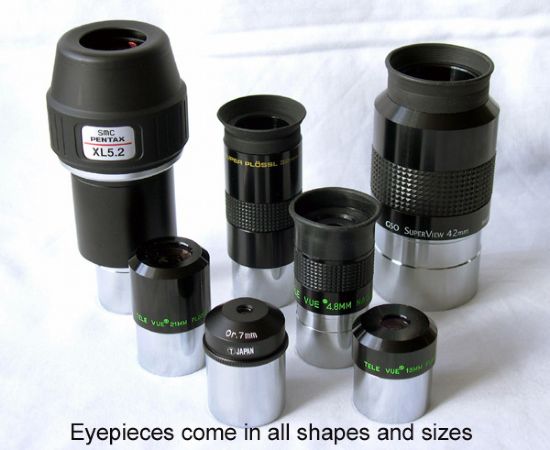Eyepiece Basics
Part 1 of an article about eyepieces by Antony McEwan
Thoughts on eyepiece designs, glass grenades, perfect plossls, and some eyepiece experiences.
 Buying a telescope is your first step on the road that will show you the wonders of the night sky. Unfortunately it is not the only purchase you will need to make along that road. Assuming your telescope has come supplied with a mount sturdy enough to support it, and a finder-scope to locate the objects you wish to observe, the next main purchase will probably be eyepieces. No doubt your new telescope will have come with a couple of eyepieces, generally a low power one and a high power one, but it’s a fairly safe bet that they are not the best that money can buy and may actually be letting your new telescope down. Before getting into this heavily, I’d better show some standard definitions, as I’ll be using these terms and formulae extensively throughout this article.
Buying a telescope is your first step on the road that will show you the wonders of the night sky. Unfortunately it is not the only purchase you will need to make along that road. Assuming your telescope has come supplied with a mount sturdy enough to support it, and a finder-scope to locate the objects you wish to observe, the next main purchase will probably be eyepieces. No doubt your new telescope will have come with a couple of eyepieces, generally a low power one and a high power one, but it’s a fairly safe bet that they are not the best that money can buy and may actually be letting your new telescope down. Before getting into this heavily, I’d better show some standard definitions, as I’ll be using these terms and formulae extensively throughout this article.
Magnification is the amount by which a given eyepiece will magnify the object under scrutiny. It is given by the following formula:

Example : An eyepiece with a focal length of 25mm being used in a telescope with a focal length of 1000mm will give magnification of (1000 / 25 ) = 40x. The image will appear 40 times larger through the eyepiece than to the naked eye.
Apparent Field Of View of an eyepiece is the value stated by the manufacturer of the eyepiece, which states the area of sky, in degrees, that the eyepiece will show.
Example : The 25mm eyepiece used in the above example may have an Apparent Field Of View (AFOV) of 50 degrees.
True Field Of View of an eyepiece is the ‘real’ area of sky the eyepiece will actually show when being used in a telescope and depends on the focal length of that individual telescope, and therefore on the magnification the eyepiece will give in that telescope. It is given by the formula:
![]()
The True Field Of View (TFOV) will change when the eyepiece is used in telescopes with different focal lengths.
Example : Our 25mm eyepiece with apparent field of view of 50 degrees, used in a telescope with focal length of 1000mm will give:
True Field Of View of [50 (AFOV) / 40x (magnification)] = 1.25 degrees.
Eye Relief is the distance from the top lens of the eyepiece at which the image will be in focus for the eye to see it. This varies between designs and is typically between 3mm and 25mm or so. When this value is very low you will have to get your eye very close to the eyepiece to see the whole field of view. This can be impossible for some eyepiece designs if you wear glasses while viewing, so it’s worth finding out the eye relief value of an eyepiece before buying.
Field Stop Diameter is the diameter of the metal or plastic ring (known as the field stop) inside the eyepiece which limits the apparent field of view. It gives the edge of field a circular edge and again varies by eyepiece type and barrel diameter.
Barrel Diameter is simply the diameter of the barrel of the eyepiece. There are three industry standards: 0.965”, 1.25” and 2”. 1.25” is the most commonly used as it replaced, for the most part, the 0.965” sized eyepieces. However, there are still 0.965” sized eyepieces available, including many made by such elite manufacturers as Zeiss, Takahashi and University Optics, so do not underestimate them! 2” barrels mean big eyepieces with larger fieldstop diameters, which enable eyepieces in this format to give wider fields of view than their 1.25” barrel counterparts.
Exit Pupil . The image that comes through the telescope, through the eyepiece and onto the surface of your eye will appear as a sharply focused disc of light. That disc of light is known as the exit pupil, and its size will vary according to how much magnification the eyepiece / telescope combination is providing. The formula to work out the size of the Exit Pupil is:

Example : The 25mm eyepiece in our 1000mm telescope provides 40x, so if the telescope has 100mm aperture the exit pupil size will be 100 (aperture) / 40 (magnification) = 2.5mm. Exit pupil size is important because if the size of the exit pupil is larger than the diameter of the observer’s dilated eye pupil, then some of the light coming through the telescope will be ‘wasted’ as the eye will not be able to take it all in. It may also be difficult to hold the eye in the right position to get a good image.
Click here to go to part 2, Eyepiece Designs